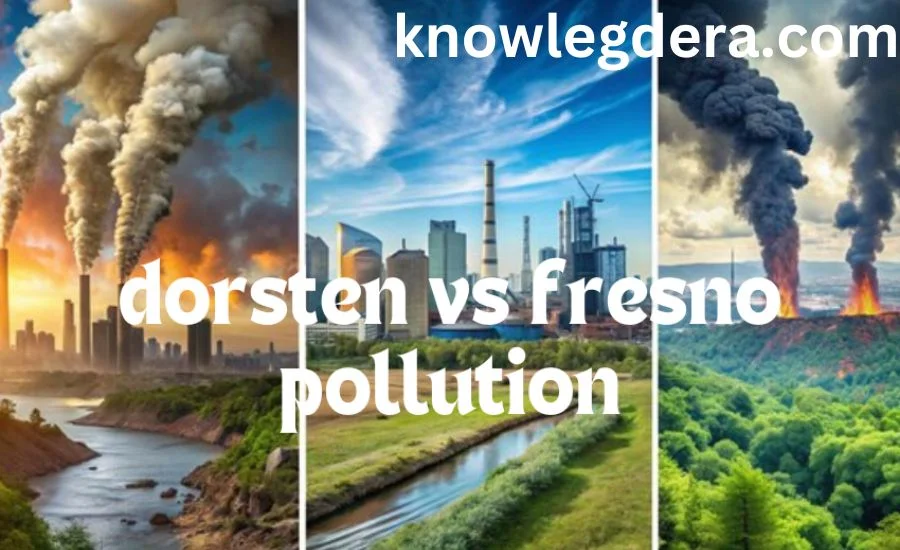Introduction
Pollution is a pressing global issue that affects the health and well-being of communities around the world. In this article, we will explore and compare pollution levels in Dorsten, Germany, and Fresno, California, USA. Both cities have unique geographical, industrial, and demographic characteristics that influence their pollution profiles. By examining various pollutants, sources, and health impacts, we can gain insights into how these two cities manage air quality and environmental health.
Overview of Dorsten and Fresno
Dorsten, Germany
Dorsten is a small city located in North Rhine-Westphalia, Germany. It has a rich industrial history, particularly in coal mining and steel production, which has influenced its development and environmental landscape. The city’s population is approximately 80,000, and it is known for its scenic parks and proximity to the Ruhr area, an industrial hub in Germany.
Fresno, California
Fresno, situated in the Central Valley of California, is one of the largest cities in the state, with a population of around 530,000. It is known for its agricultural output, being a significant producer of fruits and vegetables. However, Fresno also faces challenges related to air quality, primarily due to its geographical location and urbanization.
Key Pollutants
The comparison of pollution levels between Dorsten and Fresno will focus on several key pollutants:
- Particulate Matter (PM2.5 and PM10)
- Nitrogen Dioxide (NO2)
- Sulfur Dioxide (SO2)
- Ozone (O3)
- Volatile Organic Compounds (VOCs)
Particulate Matter (PM2.5 and PM10)
Dorsten:
- Sources: Industrial activities, traffic emissions, and residential heating.
- Average Levels: PM2.5 levels in Dorsten typically hover around 10-15 µg/m³, while PM10 levels range from 20-30 µg/m³.
Fresno:
- Sources: Agricultural activities, vehicular emissions, and dust from construction.
- Average Levels: Fresno often records higher PM2.5 levels, averaging around 20-30 µg/m³, and PM10 levels can reach up to 50 µg/m³ during peak seasons.
Nitrogen Dioxide (NO2)
Dorsten:
- Sources: Traffic, particularly diesel vehicles, and industrial processes.
- Average Levels: Dorsten’s NO2 levels average around 20 µg/m³, generally remaining within safe limits set by the European Union.
Fresno:
- Sources: Heavy traffic and industrial emissions.
- Average Levels: NO2 levels in Fresno are often higher, averaging 30-40 µg/m³, occasionally exceeding the U.S. Environmental Protection Agency (EPA) standards.
Sulfur Dioxide (SO2)
Dorsten:
- Sources: Industrial emissions, particularly from fossil fuel combustion.
- Average Levels: SO2 levels are typically low, averaging around 2 µg/m³, largely due to stringent regulations in the EU.
Fresno:
- Sources: While SO2 levels have decreased, they can spike during certain weather conditions.
- Average Levels: SO2 averages around 5 µg/m³, but historical data indicates higher peaks during agricultural burning seasons.
Ozone (O3)
Dorsten:
- Sources: Ground-level ozone is primarily formed through chemical reactions between pollutants in sunlight.
- Average Levels: Ozone levels are generally low in Dorsten, averaging around 60 µg/m³.
Fresno:
- Sources: High levels of vehicle emissions and sunny weather contribute to ozone formation.
- Average Levels: Fresno often experiences ozone levels that exceed the EPA’s standards, averaging around 80-100 µg/m³ during summer months.
Volatile Organic Compounds (VOCs)
Dorsten:
- Sources: Industrial processes and vehicle emissions contribute to VOC levels.
- Average Levels: VOCs in Dorsten are usually lower, with averages around 20 µg/m³.
Fresno:
- Sources: Agricultural practices, including pesticide use and vehicle emissions.
- Average Levels: Fresno records higher VOC levels, averaging around 40-60 µg/m³, particularly in summer.
Health Impacts
The health impacts of pollution in Dorsten and Fresno are significant and can vary based on exposure levels and individual susceptibility.
Dorsten
- Respiratory Issues: Residents may experience mild respiratory problems due to industrial emissions and particulate matter.
- Allergies: Seasonal allergies may be exacerbated by pollen and other airborne particles, although overall air quality is better than in many industrial cities.
- Long-term Health Risks: Chronic exposure to pollutants can lead to increased risks of cardiovascular diseases.
Fresno
- Asthma and Respiratory Diseases: Fresno has one of the highest asthma rates in California, largely attributed to poor air quality and high levels of particulate matter.
- Heat-Related Illnesses: The combination of high ozone levels and heat can lead to serious health complications, especially among vulnerable populations.
- Cardiovascular Diseases: Long-term exposure to pollutants has been linked to increased risks of heart disease and other chronic conditions.
Regulatory Framework
Dorsten
Germany has robust environmental regulations, enforced at both the national and European levels. The European Union’s Ambient Air Quality Directive mandates strict limits on air pollutants, which Dorsten adheres to. Continuous monitoring and public awareness campaigns play vital roles in maintaining air quality.
Fresno
California has some of the most stringent air quality regulations in the United States, primarily overseen by the California Air Resources Board (CARB). However, despite these efforts, Fresno struggles with compliance due to geographical factors and emissions from agriculture and transportation. Programs aimed at reducing emissions and improving public transportation are critical to improving air quality.
Pollution Control Measures
Dorsten
- Industrial Upgrades: Industries in Dorsten are encouraged to adopt cleaner technologies and reduce emissions through incentives and regulations.
- Public Transportation: The city promotes public transport and cycling, reducing reliance on cars and lowering traffic emissions.
- Community Engagement: Local initiatives focus on educating the community about reducing personal pollution footprints.
Fresno
- Smog Check Programs: California’s vehicle emissions standards require regular smog checks to minimize vehicular emissions.
- Renewable Energy Initiatives: Fresno is investing in renewable energy sources to reduce reliance on fossil fuels, aiming to decrease overall pollution levels.
- Community Action: Local organizations work to raise awareness about pollution’s health impacts and advocate for cleaner air.
Conclusion
The comparison of pollution levels in Dorsten and Fresno highlights the complex interplay of industrial activity, urbanization, and regulatory frameworks in shaping air quality. While Dorsten benefits from stricter regulations and generally lower pollution levels, Fresno faces significant challenges due to its agricultural base and geographical disadvantages.
Both cities illustrate the importance of continued efforts in pollution monitoring, public awareness, and regulatory enforcement. Understanding the factors contributing to pollution in these communities can help guide future policies and initiatives aimed at improving air quality and public health.
Future Directions
As both cities strive for cleaner air, the adoption of innovative technologies, increased community involvement, and effective policies will be critical. By sharing knowledge and best practices, Dorsten and Fresno can work towards achieving sustainable urban environments that prioritize the health of their residents.

